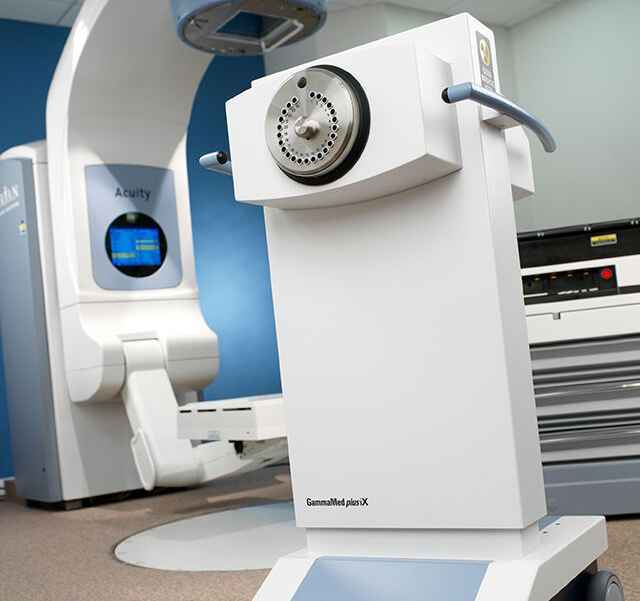Brachytherapy in Satara
- Home
- Brachytherapy in Satara

Brachytherapy (Internal Radiation Therapy)
Brachytherapy is a special type of radiation treatment where a small amount of radioactive material is placed directly inside or very close to the cancerous tumor. This allows the radiation to target the cancer more precisely, minimizing damage to the surrounding healthy tissues.
The word “Brachytherapy” comes from the Greek word “Brachys”, which means “short distance.” As the name suggests, this treatment delivers high doses of radiation at a very close range, directly where it’s needed.
How It Works
- Tiny sealed radioactive sources (called implants) are carefully placed in or near the tumour.
- These sources can be permanent or temporary, depending on the type of cancer and treatment plan.
- Because the radiation is so focused, it can effectively destroy cancer cells while protecting nearby healthy organs.
Types of Brachytherapy
- Intracavitary Brachytherapy – The radioactive source is placed inside a body cavity (like the uterus or cervix).
- Interstitial Brachytherapy – The source is placed directly into the tissue (like the prostate or breast).
- Surface or Mould Brachytherapy – A custom device is placed over the skin for tumours close to the surface.
When is Brachytherapy Used?
- Often used along with external radiation therapy (EBRT) to boost treatment at the tumour site.
- In some cases, it can be used as a stand-alone treatment, especially for early-stage cancers.
- Common cancers treated with brachytherapy include:
- Cervical Cancer
- Prostate Cancer
- Breast Cancer
- Head & Neck Cancers
- Skin Cancers
Benefits of Brachytherapy
- More precise treatment with less radiation to surrounding organs
- Shorter treatment time compared to some other therapies
- Fewer side effects
- Often done as a day-care procedure or with a short hospital stay
At Onco-Life Cancer Centre, we use advanced brachytherapy systems like the Varian GAMMAMEDPLUS IX 24-channel machine, ensuring high precision and patient safety. Our experienced team ensures that every procedure is done with utmost care, providing patients with effective and comfortable treatment.
Most Popular Questions
Satara -FAQs on Brachytherapy
1. What is Brachytherapy?
Brachytherapy is a type of radiation treatment where a small amount of radioactive material is placed inside or very close to the cancer. This helps give high-dose radiation directly to the tumor with less harm to healthy tissues.
2. How is Brachytherapy different from external radiation (EBRT)?
In external radiation, the rays come from a machine outside the body. In brachytherapy, the radiation comes from inside your body, very close to the tumor. This allows more targeted treatment and usually has fewer side effects.
3. Is Brachytherapy safe?
Yes, brachytherapy is safe when performed by trained experts. The radioactive material is handled carefully, and treatment is done under full medical supervision at our centre.
4. Which cancers can be treated with Brachytherapy?
Brachytherapy is commonly used for:
- Cervical cancer
- Vaginal and uterine cancers
- Prostate cancer
- Esophageal (food pipe) cancer
- Head & neck cancers
- Skin cancer
Your doctor will tell you if brachytherapy is suitable for your condition.
5. How is Brachytherapy done?
Special tubes or applicators are placed inside your body. These are connected to a radiation machine which sends the radioactive source into the applicators for a few minutes to deliver the dose. Then it is safely removed.
6. Is the treatment painful?
You might feel slight discomfort during placement of the applicator, but we use local or short anesthesia to reduce pain. Most patients tolerate it well.
7. How long does a brachytherapy session take?
Each session usually takes about 10 to 20 minutes, depending on the type of cancer and area being treated. Some procedures may need a short hospital stay.
8. How many sessions are needed?
The number of sessions depends on your treatment plan. For gynecological cancers, brachytherapy is usually done once a week for 3 weeks, after external radiation.
9. Can Brachytherapy be done without hospital admission?
Yes, some types of brachytherapy (like intracavitary for cervical cancer) can be done as an outpatient procedure. Others may require one-day admission.
10. Are there any side effects?
Side effects are usually mild and temporary. They may include:
- Mild pain or discomfort
- Nausea or loose motions
- Skin irritation
Most patients recover quickly and return to normal activities.
11. Can I go home the same day?
Yes, for most cases, you can go home the same day after the procedure. Your doctor will inform you if observation is required.
12. Is Brachytherapy effective?
Yes, brachytherapy is very effective in treating cancers when used correctly. It delivers high radiation precisely to the cancer cells and helps improve outcomes.
13. Will it affect my ability to have children?
For gynecological cancers, brachytherapy can affect fertility. Your doctor will guide you based on your age, cancer stage, and treatment type.
14. Do I need to take any precautions after Brachytherapy?
Usually, no special precautions are needed. You can go about your routine unless advised otherwise. Drink plenty of water and report any unusual symptoms to your doctor.
15. Why choose Onco-Life Cancer Centre, Satara for Brachytherapy?
- We have advanced radiation technology
- Experienced cancer specialists and radiation oncologists
- Safe, comfortable environment with personalized care
- Part of a complete cancer treatment facility under one roof
